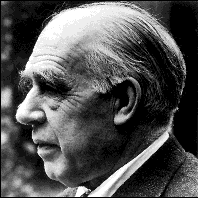Niels Henrik David Bohr
Nuclear physicist, b. 7 October 1885 (Copenhagen, Denmark), d. 18 November 1962 (Copenhagen)
 Niels Bohr was the son of Christian Bohr, professor of physiology at the University of Copenhagen, and Ellen Adler Bohr, who came from a Jewish family of bankers and politicians. He was early encouraged to follow his scientific interest and distinguished himself at university. He received his doctoral degree in 1911 with a work on the electron theory of metals.
Niels Bohr was the son of Christian Bohr, professor of physiology at the University of Copenhagen, and Ellen Adler Bohr, who came from a Jewish family of bankers and politicians. He was early encouraged to follow his scientific interest and distinguished himself at university. He received his doctoral degree in 1911 with a work on the electron theory of metals.
After completion of his degree Bohr went to England, planning to continue his work at Cambridge, but ended up in Manchester, where a group of physicists were studying the structure of the atom. He concentrated on theoretical models of the atom and was one of the first scientists who recognized the importance of the position of an element in the periodic table (which organizes all elements according to the number of natural electrical charges in the nucleus). He came to the conclusion that the nucleus of an atom may determine the atomic weight and radioactive behaviour but not the many other physical and chemical properties of an element, which are controlled by the electrons and their movement around the nucleus.
By introducing the ideas of quantum theory developed by Max Planck and Albert Einstein Bohr postulated that atoms can only exist in a set of discrete stable states of precisely defined energy levels and that atoms do not emit radiation energy while they are in a steady state but rather during transit between different steady states. This bold idea, which also meant that atoms can only emit or absorb energy in quantum jumps, was able to explain the lines seen in the spectrum of light emitted from atomic hydrogen.
In 1916 Bohr was appointed professor at the University of Copenhagen. A new Institute for Theoretical Physics with Bohr at the helm was opened in 1921. The institute, of which he remained director throughout his life, soon became an international centre for nuclear physics and quantum theory. In 1922 Bohr received the Nobel price for physics.
During the 1930s the work of the institute naturally lead to discoveries related to nuclear fission, and by 1939 the process (the splitting of the atom to produce very large amounts of energy) was basically understood. After the German occupation of Denmark in 1940 Bohr continued to work in Copenhagen until 1943, when Bohr's unconcealed opposition to Hitler's regime and his Jewish ancestry made an arrest more and more likely. He and his family fled to Sweden by fishing boat and were airlifted to England by the British government.
In England Bohr and one of his sons joined the British effort to produce a nuclear bomb and went to Los Alamos to assist the USA in building its bomb. He soon became concerned about the consequences and tried to persuade Churchill and Roosevelt of the need of an international safeguard arrangement, but to no avail.
In 1955 Bohr was instrumental in bringing about the First International Conference on the Peaceful Uses of Atomic Energy. He helped establish the European Council for Nuclear Research (CERN). Bohr was president of the Royal Danish Academy from 1939 until his death in 1962.
Reference
Klein, M. J. (1995) Niels Henrik David Bohr. Encyclopaedia Britannica 15th ed.
home
 Niels Bohr was the son of Christian Bohr, professor of physiology at the University of Copenhagen, and Ellen Adler Bohr, who came from a Jewish family of bankers and politicians. He was early encouraged to follow his scientific interest and distinguished himself at university. He received his doctoral degree in 1911 with a work on the electron theory of metals.
Niels Bohr was the son of Christian Bohr, professor of physiology at the University of Copenhagen, and Ellen Adler Bohr, who came from a Jewish family of bankers and politicians. He was early encouraged to follow his scientific interest and distinguished himself at university. He received his doctoral degree in 1911 with a work on the electron theory of metals.